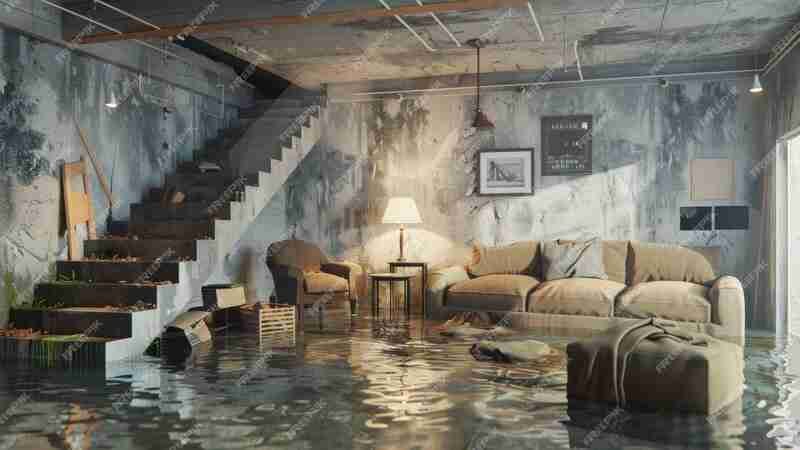Water damage in your basement is not just a nuisance; it can lead to severe structural issues, mold growth, and health hazards. This comprehensive guide provides an in-depth look at effective strategies to address and prevent water damage in your basement. By following these steps, you can mitigate the impact of water intrusion and protect your home from extensive damage.
Understanding Water Damage in Basements
Common Causes of Basement Water Damage
Basement water damage can stem from various sources, including:
- Heavy Rainfall: Intense storms can overwhelm drainage systems, leading to water seepage.
- Faulty Gutters and Downspouts: Clogged or damaged gutters can cause water to pool near the foundation.
- Poor Drainage: Inadequate grading around your home can direct water towards the basement.
- Plumbing Leaks: Broken pipes or faulty plumbing fixtures can introduce water into your basement.
- Sump Pump Failure: A malfunctioning sump pump can fail to remove excess water, leading to flooding.
Signs of Water Damage
Identifying water damage early is crucial for effective remediation. Look for these signs:
- Water Stains: Discolored spots on walls or ceilings indicate moisture intrusion.
- Peeling Paint or Wallpaper: Water damage often causes paint or wallpaper to peel.
- Musty Odor: A persistent damp smell suggests hidden mold or mildew.
- Visible Mold: Mold growth on walls, floors, or ceilings signifies excessive moisture.
Immediate Steps to Take When Water Damage Occurs
1. Ensure Safety First
Before addressing water damage, prioritize safety:
- Turn Off Electricity: If water has reached electrical outlets or appliances, shut off the power to prevent electric shock.
- Wear Protective Gear: Use gloves, boots, and a mask to protect yourself from contaminants and mold spores.
2. Remove Standing Water
If safe to do so, remove standing water as quickly as possible:
- Use a Wet-Dry Vacuum: A wet-dry vacuum can efficiently extract water from floors and carpets.
- Mop and Towels: For smaller amounts of water, use mops and towels to soak up moisture.
3. Dry Out the Area
Thorough drying is essential to prevent further damage:
- Use Dehumidifiers: Dehumidifiers help to remove moisture from the air.
- Increase Air Circulation: Open windows and use fans to expedite the drying process.
- Remove Wet Materials: Remove soaked carpets, padding, and other materials that can retain moisture.
Long-Term Water Damage Remediation Strategies
1. Repair and Seal Basement Walls
Cracks and leaks in basement walls must be repaired to prevent future water intrusion:
- Fill Cracks: Use hydraulic cement or epoxy injections to seal cracks in concrete walls.
- Waterproofing Sealant: Apply a waterproofing sealant to the interior walls to create a barrier against moisture.
2. Improve Drainage Around Your Home
Effective drainage is crucial for preventing basement water damage:
- Maintain Gutters and Downspouts: Regularly clean gutters and ensure downspouts direct water away from the foundation.
- Grade the Landscape: Ensure the ground slopes away from your home to prevent water from pooling near the foundation.
- Install a French Drain: A French drain can help divert water away from your basement.
3. Install and Maintain a Sump Pump
A sump pump is essential for managing groundwater:
- Choose a Quality Sump Pump: Select a reliable pump with a battery backup to ensure operation during power outages.
- Test Regularly: Periodically test the sump pump to ensure it functions correctly.
- Clean the Pit: Regularly clean the sump pit to prevent debris buildup.
4. Address Plumbing Issues
Inspect and repair any plumbing issues to prevent future leaks:
- Check Pipes: Regularly inspect pipes for signs of leaks or corrosion.
- Fix Leaks Promptly: Address any leaks immediately to prevent water damage.
Preventive Measures to Avoid Future Water Damage
1. Regular Maintenance
Routine maintenance can prevent water damage:
- Inspect for Cracks: Regularly check the foundation and walls for cracks and repair them promptly.
- Clean Gutters: Clean gutters and downspouts to ensure proper water flow.
2. Install a Vapor Barrier
A vapor barrier can help prevent moisture from entering the basement:
- Choose the Right Material: Use a high-quality polyethylene sheet as a vapor barrier.
- Install Properly: Ensure the barrier covers the entire floor and overlaps at seams.
3. Consider Basement Waterproofing Systems
For comprehensive protection, consider professional waterproofing systems:
- Exterior Waterproofing: This involves excavating around the foundation and applying a waterproof membrane.
- Interior Waterproofing: Includes installing drainage systems and sump pumps inside the basement.
Conclusion
Dealing with water damage in your basement requires a combination of immediate action and long-term prevention strategies. By understanding the common causes of water damage, taking prompt action to address issues, and implementing preventive measures, you can protect your home from the adverse effects of water intrusion. Regular maintenance and professional waterproofing solutions offer additional protection and peace of mind. For effective water damage management, be proactive and vigilant, ensuring that your basement remains dry and safe.
